

|
Back to |
| The Front Page |
| News & Features |

|
Hawkins assumes Croquet World co-editorship |
|
|
by Bob Alman and James Hawkins layout by Reuben Edwards Posted March 20, 2006
|
|
James Hawkins, former editor of the English Croquet Gazette, assumes the co-editorship of Croquet World Online Magazine - www.CroquetWorld.com - effective today, mid-March of 2006.
Hawkins, 37, has over 20 years of playing experience on the English tournament circuit. His first ever club game, at a wet and windy Southport Croquet Club in June of 1985, was against the 13-year old Chris Clarke. Since then, he’s gone on to play throughout the UK, in both Association and Golf Croquet events.
In 2001 he assumed the role of Editor of the [English] Croquet Gazette, which he held until 2005, steering away from the tradition of reporting comprehensive and detailed tournament results, and towards a fully-fledged magazine. “I inherited a magazine which needed to be all things to all of its readers. In a game increasingly fragmented between the formats of Golf, Handicap-level Association and Advanced-level Association, this was becoming more and more difficult.” His policy evolved to take an international focus, to examine in much greater detail some of the workings of the Croquet Association’s organization, and to dip into unexplored areas of the game’s history.
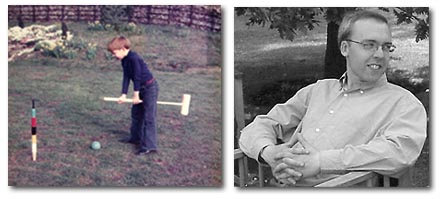
|
| James Hawkins then and now: He comments, “When I was eight or so my grandfather bought a field at the back of his retirement home in the Lake District. With a pickaxe and a wheelbarrow – and nothing else – he set about single-handedly excavating it, leveling it, and returfing it as a croquet lawn. That’s where I’m playing in this photo, circa 1977. So, you see, mad schemes to set up croquet lawns from nothing are in the blood.” The adult Hawkins lives in Liverpool not far from the public lawns he intends to develop in partnership with the Liverpool City Council." |
“There’s a degree of complacency in the English game,” Hawkins claims. “Development in much of the country has provided a healthy and stable environment for clubs to thrive. Elsewhere, and particularly overseas, croquet struggles for its survival. There’s an onus to show how lucky many players are, how reliant they have been on the Croquet Association’s work – particularly in development of new clubs – and how this situation compares with elsewhere. What’s more, we can learn a great deal about our own futures from the lessons of the game’s history. The blind alleys and successes of other versions of croquet – whether it’s roque in America, gateball in Japan or golf croquet in Egypt – teach us valuable lessons. Report, comment and analysis should be the three watchwords of anyone with an interest in their own version of croquet.”
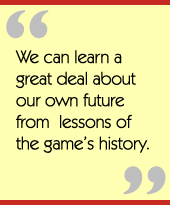
As co-editors Hawkins and Alman will operate autonomously in their writing and editorial roles - that is, both writing articles and soliciting and editing articles and other magazine content from outside sources. Inevitably, Hawkins' co-editorship brings a much-needed and long-overdue trans-Atlantic balance to the magazine, founded by Alman almost ten years ago, largely as the "news and features" arm of www.CroquetAmerica.com, the official website of the USCA which Alman also founded at about the same time.
But, Alman notes, www.CroquetAmerica.com is being extensively redesigned and expanded at the same time, and somewhere around the middle of the year, it will be turned over to others - Leo Nikora of Maui as the webmaster, and Jeff Soo of North Carolina as the editor.
"So the 're-launch' of www.CroquetWorld.com to broadens its base in other parts of the globe is a very timely development," Alman notes. "It's not only about balancing the international coverage with more content from Europe. In fact, the advent of James Hawkins is part of an overall re-invention of the magazine that includes more coverage on all the continents, and more active correspondents everywhere.
"The overall intention of the development calendared for this year - 2006 - can be summed up briefly: We want to make www.CroquetWorld.com fully achieve its promise as the indispensable gateway to the world of croquet, for everyone - for the ‘serious’ croquet-playing population, as well as for the greater public looking for a meaningful inside view of the global croquet culture: one that is accessible and understandable.”
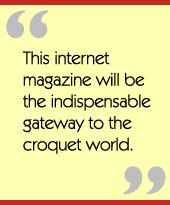
Hawkins concurs with this view of Croquet World's potential. "'Why am I here?’ was a question I asked myself at length when I was putting together the Gazette.” He recalls. "For an online magazine, much of the reason for existence must be to spread the word of croquet to a wider public. I’ve spent much of my life apologizing to acquaintances for being a croquet player. Perhaps this is more true in the UK than in the US or elsewhere, but croquet has such a high recognition factor among the public, but an equally high level of ridicule. We can either turn a blind eye to those Alice-in-Wonderland class-ridden 19th Century stereotypes, which have stuck with croquet, or confront them head-on. Croquet World’s role must be to act as a shop window for promoting our game outside, while at the same time providing an entertaining and informative forum for our existing community.”
Defining the “re-launch” of Croquet World
"Now that it's possible to remedy the situation," Alman comments, "it's okay to acknowledge that Croquet World has been at least half "Croquet America", and we can change that in many ways, spanning oceans and continents in our coverage, but also with the 'Universal Index of Croquet Links' I've already started working on." The Universal Index is designed to make www.CroquetWorld.com a true gateway to the entire world of croquet content, on all the websites, without bias.
Why is the Index needed? "Because the search engine technology has not advanced sufficiently to give you what you want, in most cases, without a lot of sifting through useless and extraneous data dragged up by the automatic search spiders," Alman comments. "We all know this. So if there is an index built on SUBJECTIVE criteria, attached to its own search engine, searching content consciously put into the Index according the to real content of each document, that will make it comparatively easy for you to find what you're looking for. Because all the content will be organized in index form as well as powered with a search engine, you'll have multiple ways to research your subject.”
If the project sounds labor-intensive, that's because it is. "I plan to build the skeleton of the Index with content from www.CroquetWorld.com - I've already started - and then we'll program a special administrative interface to facilitate moving index heads and subheads around and plugging in an active, lighted link for each entry. Our index will be eminently scannable, because most entries will be just one line long, begun with a lighted link behind the subject content."
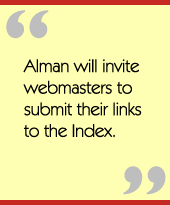
After the Index framework and the programming is completed and debugged, Alman will then invite the webmasters of approximately 100 "major croquet websites" to submit their links to the Index. Only site-generated content will be eligible. "There’s a lot of stealing of content that goes on, on all parts of the web," Alman comments, "and although this is not exactly a high crime, I do think it's just a little unethical, and I certainly don't want to reward anybody who steals content without attribution with an active link to their website. Also, I don't want duplicates in the Index, so the 'site-generated' rule has a very practical value."
Broader currency of the Events Bulletin Board
One aspect of the "American bias" of www.CroquetWorld.com is seen in the EVENTS BULLETIN BOARD divided into five regions of the world: The Americas, Europe, New Zealand, Australia, and Africa/Asia/Pacific. Most of the postings are in The Americas section of the board, even though the entire world has access to the board on an equal basis. The Board is uniquely programmed to allow postings by anyone, from everywhere, with content neatly indexed and easily accessible, constituting an eternal - and infinite - record of croquet events for as long as the board has been operating - since 1998. "I very much hope that with our broader coverage, other countries will see fit to use the board more frequently, and even to link to it from their websites. It was developed as a universally available resource, and it's a shame it hasn't been used like that, except in America, until now."

Hawkins and Alman expect that active recruitment of more correspondents throughout the world, reporting major croquet events in their countries, will help to build the currency and popularity of this BULLETIN BOARD in other countries. “The combination of this programming of the Board and the infinite online database is really unbeatable. It took forever to de-bug, and it’s almost perfect now. It really ought to be linked from every major website,” Alman comments, “but I understand that it won’t be, because many webmasters don’t like to link to another site. That isn’t true of www.CroquetWorld, by the way. I have never asked permission to do a “mirror” version of somebody else’s article; when there’s something offsite that deserves notice, I banner it on the front page and link directly to it. That’s what the Web is about, to me – it’s about using these fantastic resources to the max, and giving the originators of the material the acknowledgement and the Web traffic they deserve for producing it…”
Alman notes that the programming behind the EVENTS BULLETIN BOARD and other special features of www.CroquetWorld.com were funded by the Croquet Foundation of America, through a grant from Ellery McClatchy, one of the principal long-time patrons of the sport in America. McClatchy continues to fund the work that goes into www.CroquetWorld.com, and that funding is used largely to reimburse - at a modest level - the people who do the technical support of the site at a high level of professional competence - the Webmaster and the layout artist and designer, in particular.
Learning the croquet business at club level
In addition to writing and editing credits, Hawkins and Alman share a long-time commitment to local club development. The San Francisco Croquet Club - the first two-lawn municipal facility in the U.S. - was largely a laboratory of development in the eighties and early nineties. It became a famously successful and comparatively wealthy club. Alman wrote about the club's development and other club developments in the three-volume Monograph Series on Club Building, Organization and Management, published by the Croquet Foundation of America.
Alman continues to consult on local club starts and program development. "And as editor of Croquet World," he notes, "I am regarded by the press, naturally, as ‘the world's greatest authority.’ I never argue the point, media relations happened to be a big part of my professional background, and I think I'm pretty good at working with the numerous writers and editors who call about the croquet stories they're developing. Most of those stories are US-based, and for publication in this country. And now - as James will soon find out - he will automatically become the main croquet press contact for Europe. It makes sense: the editor of Croquet World just HAS to be the credentialed authority that every good writer or editor needs to give their croquet story credence."
Club prospects in Liverpool
Hawkins’ depth of experience in all matters croquet bolsters his credentials as a legitimate croquet expert on many levels, including club development. He is the moving force behind a development project in Liverpool that is close to the scale of the National Croquet Center in Florida. While organized croquet has been well developed since its inception along the south coast and in the south west of England, the North has traditionally been a desert for the game, Hawkins says. “Twenty years ago, when I started playing, there were seven clubs in the north west. Now there are twice that many. And five of them have four or more lawns, suitable for tournament events. Even so, Liverpool, with a population of 500,000, has never had a club within 30 miles. I’m trying to sort that out.”
The plans are exciting and ambitious. Hawkins has located a disused soccer pitch, with space for six rough-and-ready lawns, and has tentative agreement on leasing the space from the City Council. The next five years will be make-or-break time. “Before Christmas, I had no lawns, no money and no members. Now I’m a third of the way there. Starting from scratch allows me to think about how the perfect club would look. Obviously, being two miles from the airport forces me to think of the club’s long-term target as a premier international championship venue, but that’s years and years away. Before that happens, there’s the issue of access for new members.
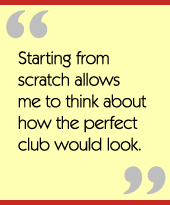
“British sport is adamant in its resolve to promote physical activity to minority groups. Here we are with a sport appealing to an 80-year age range, with no gender bias, and with no exclusions for people with disabilities – and yet, we remain the poor relation of soccer, tennis and the rest. To set this club up in Liverpool, and to set it up on the cheap, is going to be tough work. But if it works, this could be the template for every city – Leeds, Sheffield and Bradford among them – where there’s no provision for croquet.”
Road of development takes many turns
This all sounds very familiar to Alman, who started the development work in San Francisco more than two decades ago and was the major organizing force in the San Francisco Croquet Club until he moved to Palm Beach County late in 2000, to organize and manage all the functions of the National Croquet Center for membership, event sales, and administration. He left that full-time post in July of 2003, 14 months after the clubhouse opened and the Center had become a fully functioning entity, with a club membership approaching 300.
After leaving the Center staff, Alman entered a partnership with The Toequet Company in Terre Haute, Indiana - producing super-sized wicketsports equipment - which includes responsibility for national development and marketing for the company. In addition, Alman produces Malletball events locally for school, corporations, and private parties through his one-man company, Wicketsports Unlimited. With Reuben Edwards as design partner, Alman also created and manages the company website, www.Malletball.com, which sells equipment and details suggested rules for various group sizes and purposes.
"It all sounds like a lot," Alman comments, "but actually, it isn't. These are small enterprises with minimal overhead, and most of the work is just putting together the marketing framework and answering the phone, and doing the events - which I actually enjoy very much. I only do an average of one event a week, so it’s not a burden. The only ones that are really difficult are the After-School programs and camps for teenagers. They usually require every ounce of energy I have. It’s the only time I begin to feel my age – which is really beyond the age when a lot of people retire." Alman, at 66, is almost three decades older than Hawkins.
"After being here five years, I'm beginning to like Florida and, I think, to understand what it's about. I would never consider a full 'retirement', and Croquet World is going to be the main focus of my energies for a long time to come, I think. But at the same time, I'm getting interested in other things, new things: writing poetry - which of course has no income potential at all; tramping through the wilderness with the Sierra Club, preserving wildlife habitat - another job that not enough people are doing because there's no money in it.

"I've been doing these websites for ten years," Alman comments. "That's a lot longer than I've done anything, ever in my life, because most of my professional life has been about getting things started - not about tending them forever. So I really need this 're-launch' to reinvent my own commitment to Croquet World - and it's working! The creative juices are flowing again. I'm really excited about recreating the magazine on a significantly expanded editorial and advertising platform. It's the kind of work that really needs the kinds of skill I have in bringing new things into being, so for the present, I'm totally happy with the process.
"The best reason I have to be happy about all this is the team I have to work with: the original Webmaster, Bob Henry of Wichita, Kansas, has done too many heroic deeds to mention here, and he is still on board, trouble-shooting with ISPs who can sometimes do some pretty incredible things to mess up a website, and providing specialized programming when it's needed, expertly and with good humor. My friend Adam Stock in San Francisco did a great job with the original design of both www.CroquetAmerica.com and www.CroquetWorld.com, he took the whole game to a new level of professionalism we never would have achieved without him, and he still checks in from time to time when he’s not busy starting up new enterprises himself.
"Reuben Edwards happens to be the only person I ever heard of who learned how to play croquet by watching - this was at an early-nineties edition of the San Francisco Open. He became a very good player, and at the same time, he came on early to do the article design and layout work that makes Croquet World the attractive, accessible, and user-friendly magazine it is. He's a good artist, and a great person. And now we have James. I really like working with a good team, with bright, committed, no-bullshit, let’s-get-it-done-right people. That's half the joy, at least, of doing good work, sharing it with a great team. I probably wouldn’t have started the magazine at all, by the way, if I hadn’t thought that my old friend Mike Orgill would be a big part of it.” (As it turned out, Orgill was involved in a major way only the beginning, before the pressures of working fulltime and commuting to San Francisco from his Rohnert Park home became too distracting to allow for a significant commitment to writing and editing on the magazine. Follow the link to “We Interview Ourselves” to read their notions of what they thought the magazine should be, ten years ago.)
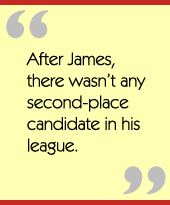
If Alman, at 66, is contemplating limited retirement, James Hawkins, at 37, is a long way from there. "I'm assuming he'll last a lot longer than I will," Alman comments. "And it's good to know that if I should have a bad encounter with a 15-foot alligator in Loxahatchee Slough, the future of www.CroquetWorld.com would still be in good hands.
“The truth is that when I started looking around for candidates for this job, there wasn’t a second place. Excuse me for insulting any other candidates out there I don’t know about, but I really don’t see anybody else in his league for this job. And as you will soon see, we’re off to a running start because we’ve already worked together in the past, very successfully. You can see lots of James Hawkins articles posted on Croquet World, and you may recall a number of Bob Alman articles in Hawkins’ Gazette, as well as the Gazette of Gail Curry. I think the Web format will liberate a lot of Hawkins’ ideas about the possibilities of croquet content in this medium. If I have to run to keep up with him…so much the better.”
There’s one issue between Hawkins and Alman that may never be resolved, and that is the perpetual compromise called “North Atlantic English.” Only for pedants would it be a serious problem, according to Alman, because, “I really don’t care whether colour is spelled with a ‘u’ or not, and for James’ part, I think he could dispense with it. As a matter of fact, in this early joint effort of writing an article together, I can honestly say that I encountered none of those puzzling British colloquialisms that clutter the Nottingham Board. So it’s pretty clear we’ve found a common language, one that can be read and understood in all the English-speaking countries. So if the articles mix and match local spelling preferences, that doesn’t bother me. The important thing is to be understood.”